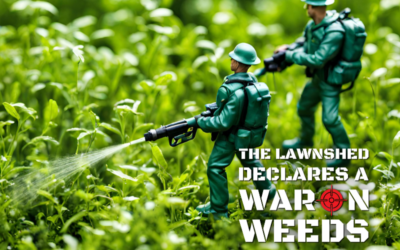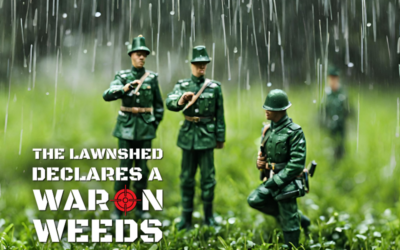Winter grass or Poa annua is exactly as the scientific or botanical name describes it. Poa meaning grass and annua meaning annual. In this blog we deep dive into the weed that is wintergrass, exploring its life cycle, ways to treat it both curative and preventative, as well as exploring the reasons for its occurrence.
What is Wintergrass?
Wintergrass is a weed that has many names including Annual Meadow Grass in the UK and Annual Bluegrass in the US, sometimes these names creep into articles in Australia, for those who know it best we simply call it Poa.
It’s a tufted grass that becomes very big throughout the cooler periods of the year and can often mean extra mowing in the middle of Winter that isn’t normally required.
It’s lime green in colour, with fine leaves that are approximately 2-4mm in width. It’s most identifiable features though are it’s leaf tip that is “boat shaped” like the front of a boat and it’s seedhead which has a huge number of seeds come Spring. A slight blue tinge to these seeds is where the blue grass name comes from.
It’s one of the worlds most widespread weeds but Australia has a large range of temperatures and so its prevalence is mostly distributed in the southern or cooler areas in Australia.
The Wintergrass lifecycle
The name Poa annua tells you a lot Poa derived from the grass family Poaceae and annua simply the latin for annual.
An annual as you may know from dealing with plants like Petunias, Cosmos and other plants is a plant that likes a certain season. In Australia a lot of our weeds love Winter, as our predominately warm season grasses slow down they see their chance and weeds like Bindii and Wintergrass pounce.
So Wintergrass germinates as soil temperatures drop below 12 degrees (that’s why it’s not a problem in NT and QLD, it just doesn’t get cold enough), with a slight variation in biotypes germinating at slightly higher and cooler temperatures. For areas like Sydney this generally occurs in late-February but can occur early in more southern states.
Soil temperature is generally stable however a week of rain in early February can quickly have some early Wintergrass germinating.
It grows through Winter and by the end is quite large the large weed.
As Spring arrives the older leaves start to go yellow and seeds begin to develop. Ensuring its survival for next year.
Curative treatments of Wintergrass
When we see weeds we want to knock it out but when it comes to a grass within a grass it becomes a whole lot more complicated.
Every herbicide impacts the off-target species to some degree, even if the results aren’t overly obvious. So, when it comes to treating Wintergrass we need to be careful we don’t do a lot of damage.
Early in the season when Wintergrass is small we can use propyzamide to stop the Wintergrass from creating more roots, without this ability it can’t survive.
As the season progresses however it becomes bigger, healthier and more difficult to control. Results at this stage for most herbicides are generally disappointing so we don’t recommend control at this point. Simply learn about pre-emergents, make a note in your diary for February next year and wait for the existing Wintergrass to die out as temperatures increase.
Preventative treatments of Wintergrass
This is 100% the best way to treat Wintergrass. It’s how the pros do it and so that’s how we recommend doing it. After all it’s much easier to make a single application and prevent the Wintergrass than make multiple post emergent applications, pull them by hand or lots more mowing.
The two major sets of products we use for pre-emergent control of Wintergrass are:
Prodiamine: An extremely powerful active that we have in both Spartan and Barricade products. It forms a barrier in the soil, preventing new root development in the very top layer. For our established turf its roots are beyond this layer so impact is minimal, but for newly emerging Wintergrass this is a huge issue and control is impressive. Last for up to 6 months.
When to Use: February on established warm season turf including Buffalo, Couch, Kikuyu, Zoysia
When not to Use: When you have new turf or seed. Cool season grasses like Fescue, Rye.
Oxadiazon: Similar to other pre-emergents, Oxstar forms a barrier in the soil but this does not impact the root development, instead impacting shoot development. So for a new lawn developing roots there is no issue but for a weed trying to put up its first leaf it poses serious complication and it is forced to die out. Last for 8-12 weeks.
When to Use: New turf or newly seeded lawns.
When not to use: When starter fertiliser is not required. cool season grasses like Fescue, Rye.
Why we get Wintergrass
It’s one of the worlds widest spread weeds so there is always that, but here we wanted to cover what conditions contribute to its prevalence.
Wintergrass just loves wet areas so in lawns where shade is an issue (being in the southern hemisphere this is at the very least your northern fence line) it identifies the thinner turf as we head into Winter and takes the opportunity to invade. If the area is compacted than that’s a bonus. When it first comes into your lawn it may only be a few weeds so alarm bells should ring and these should be pulled before it can seed. Once it seeds however you will need to get on the pre-emergent schedule as the seeds can last up to 7 years and there is a lot of them.
Hopefully that’s helped and you can jump over to get some Barricade, Spartan or Oxstar to prevent Wintergrass. We care about your timing so make sure you register for our newsletter so we can remind you about when to apply.
If you’re looking for fantastic advice on any aspect of lawn care then you should follow along on our YouTube channel, LawnFlix where our resident Lawn Genius shows you how to apply, how to calculate and just generally everything lawn related.
FAQ
How to use Spartan?
Spartan can be applied at the low rate of 20ml per 100m2. That’s less than $5 per 100m2 to prevent lots of mowing or dealing with Wintergrass for 6 months.
What’s the difference between Spartan and Barricade?
They both contain the same concentration of Prodiamine. The 2 major differences are, pack size with Barricade being a 1L pack and Spartan being a 500ml pack. Barricade is registered for and comes with directions for preventing weeds in garden beds as well.
Do pre-emergents prevent other weeds?
They certainly do, many other grass weeds and even some broadleaf ones as well.
Is there a way to prevent or kill Wintergrass in cool season grasses?
There is, it’s super expensive (like thousands) and only registered for commercial applications. Sorry.




